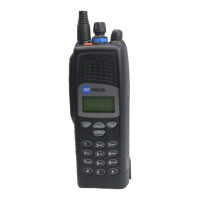TP9100 Service Manual CODEC and Audio Fault Finding 285
© Tait Electronics Limited May 2005
Task 12 —
Initial Checks of the
External (Accessory)
Microphone
Carry out the following checks to isolate the part of the circuitry that is
faulty.
1. Check the connector PL1 (see Figure 12.1) and the flexible acces-
sory board connection to the main board as defined in “Accessories
Interface Faulty” on page 147. Assuming this is correct, proceed to
Step 2.
2. Check the DC level on the
ACC MIC signal on pin 6 of PL1.
3. If the DC level is not present check and repair components and
soldering around PL1, E901, and C910 (see Figure 12.1). If the
signal is present, the audio path is suspect; go to Tas k 13
.
4. Confirm the removal of the fault and go to “Final Tasks” on
page 134. If the repair failed, the DC bias is suspect; go to Task 1 4
.
Task 13 —
Check External
(Accessory)
Microphone Audio
To check the modulation from the external microphone:
1. Apply an AC-coupled 1kHz audio signal with level 9.5mV
rms
to the
ACC MIC signal on pin 6 of the connector PL1.
2. Check that the audio signal appears at the junction of R229, R232,
and C213 (see Figure 12.3):
3. If the signal is not present, check and repair components and
soldering around R229, R232, and C213 (see Figure 12.3). If the
signal is present go to “Frequency Synthesizer Fault Finding” on
page 159.
4. Confirm the removal of the fault and go to “Final Tasks” on
page 134. If the repair failed or the fault could not be found, replace
the main board and go to “Final Tasks” on page 134.
pin 6 of PL1: 3.0 ±0.3V (typical)
junction of R229, R232, and C213: 9.5mV
rms
with 1.5V DC offset

